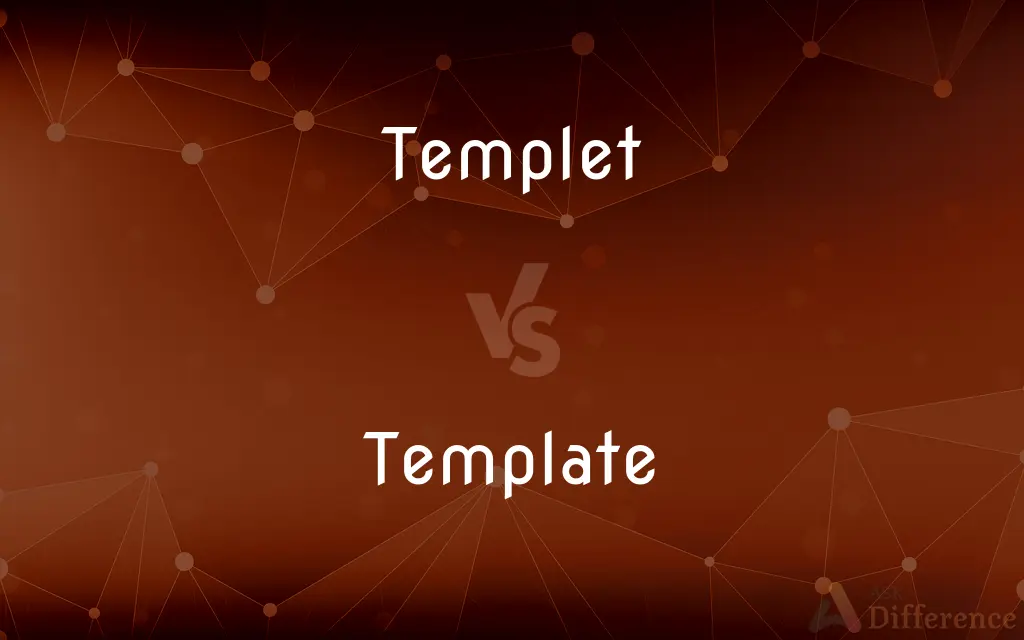Templet vs. Template — What's the Difference?
By Tayyaba Rehman — Updated on August 22, 2023
A templet is an older term for a physical pattern, often for guiding tools; a template refers broadly to any mold, pattern, or overlay, especially in digital contexts.

Difference Between Templet and Template
Table of Contents
ADVERTISEMENT
Key Differences
The term templet, often considered archaic, primarily denoted a physical pattern, especially one used in manual tasks such as shaping metal or wood. In contrast, template has a more extensive range of applications, encompassing both physical and digital patterns.
Historically, templet was a term craftsmen might have used to refer to a physical gauge or pattern that assisted them in their tasks. For example, a woodworker could use a wooden templet to trace out a specific design or shape. On the other hand, template over time has become more associated with the idea of a pre-established pattern or format that can be replicated, especially in computing, where it denotes predefined formats for documents, websites, and more.
The distinction between templet and template in modern language usage is more about context and frequency. While templet is seldom used in everyday speech, the term template is commonplace, particularly in the realms of design, software, and business. Anyone working with software like Word or PowerPoint will be familiar with templates – pre-formatted designs that provide a starting point for a document or presentation.
To put it succinctly, while both templet and template imply a kind of pattern, templet is antiquated and primarily pertains to physical models. In contrast, template is widely used today in various contexts, predominantly digital, representing predefined patterns or formats.
Comparison Chart
Etymology
Derived from the Old French "templet," meaning small temple.
From Latin "templum," space marked out, though now more associated with pattern or mold.
ADVERTISEMENT
Common Usage
Older, less common term.
Broadly used in modern contexts, especially digitally.
Physical/Digital
Primarily physical patterns or molds.
Can refer to both physical molds and digital formats.
Fields of Use
Woodworking, metal shaping.
Design, software, business, and more.
Modern Context
Considered archaic; seldom used.
Common and versatile in contemporary language usage.
Compare with Definitions
Templet
An archaic term for a rigid pattern used for shaping or checking the shape of an object.
He used a wooden templet to trace the intricate design on the metal.
Template
A standard or example for imitation or comparison.
The initial design served as a template for all subsequent models.
Templet
A gauge or pattern for molding.
The potter used a templet to ensure consistent shape and size for each pot.
Template
A pattern used in graphic design or word processing.
The flyer was created using a template from the design software.
Templet
A physical guide for tools during a manual operation.
The blacksmith had a series of templets for crafting different parts of the armor.
Template
A digital file containing a standard design or format.
Websites often use templates to maintain a consistent look and feel.
Templet
A mold or pattern made of metal, wood, or another material.
With the right templet, even a novice can craft a beautiful piece of art.
Template
A model or mold used as a guide in making things.
The jeweler had a template for each unique ring design.
Templet
Variant of template.
Template
A predefined format or structure.
She selected a template for her presentation to save time on design.
Templet
Archaic form of template
Template
A timber or plate used to distribute the weight in a wall or under a support.
Templet
A gauge, pattern, or mold, commonly a thin plate or board, used as a guide to the form of the work to be executed; as, a mason's or a wheelwright's templet.
Template
(Biochemistry) A molecule of a nucleic acid, such as DNA, that serves as a pattern for the synthesis of a macromolecule, as of RNA.
Templet
A short piece of timber, iron, or stone, placed in a wall under a girder or other beam, to distribute the weight or pressure.
Template
An overlay that fits over all or part of a keyboard and has labels describing the functions of each key within a particular application.
Templet
A model or standard for making comparisons
Template
A strip of metal used in boiler-making, pierced with a series of holes, and serving as a guide in marking out a line of rivet-holes.
Templet
An old term for a standardized guide in design.
The architect referred to his wooden templet while sketching the building's layout.
Template
A shaped piece of rigid material used as a pattern for processes such as cutting out, shaping, or drilling.
Template
A pattern or gauge, such as a thin metal plate with a cut pattern, used as a guide in making something accurately, as in woodworking or the carving of architectural profiles.
Template
A document or file having a preset format, used as a starting point for a particular application so that the format does not have to be recreated each time it is used
A loan amortization template for a spreadsheet program.
Template
A horizontal piece of stone or timber used to distribute weight or pressure, as over a door frame.
Template
A physical object whose shape is used as a guide to make other objects.
Template
A generic model or pattern from which other objects are based or derived.
Template
(computing) document template file with a basic outline for a work
Template
(molecular biology) A macromolecule which provides a pattern for the synthesis of another molecule.
Template
A partially defined class or function, that can be instantiated in a variety of ways depending on the instantiation arguments.
Template
To provide a template or pattern for.
Template
Same as Templet.
Template
A model or standard for making comparisons
Template
To set up or mark off using a template.
Common Curiosities
What's a templet?
A templet is an older term, primarily referring to a physical pattern or mold, especially used in manual operations like woodworking.
Is templet still in common use?
Templet is considered archaic and is not frequently used in modern English, especially compared to template.
How does template differ from templet?
While a templet usually refers to a physical pattern, a template can mean both physical and digital patterns or formats and is more commonly used in today's language.
Can I use template in a digital context?
Absolutely. The term "template" is widely used to describe preformatted digital designs, such as website themes or document layouts.
Would a carpenter use a templet or a template?
Historically, a carpenter might have used a "templet" as a physical guide. Nowadays, they might use the term "template" more generically.
Would it be incorrect to use templet in place of template?
While not technically incorrect, using "templet" in modern contexts might sound outdated or unfamiliar to most listeners or readers.
Do both terms originate from the same root?
Both templet and template are derived from terms suggesting a pattern or model, with templet coming from Old French and template having Latin roots.
In what scenario would I encounter the word templet?
You might come across "templet" in older literature or in specific contexts related to manual crafts or historical references.
Why don't I see "templet" in contemporary texts?
The word "templet" has become outdated, with "template" becoming the more prevalent term due to its broader applicability.
Can a template be something intangible?
Yes, in addition to physical patterns, a template can also refer to abstract models or standards, especially in design or computing.
Share Your Discovery

Previous Comparison
Wood vs. Woods
Next Comparison
Benefiting vs. BenefittingAuthor Spotlight
Written by
Tayyaba RehmanTayyaba Rehman is a distinguished writer, currently serving as a primary contributor to askdifference.com. As a researcher in semantics and etymology, Tayyaba's passion for the complexity of languages and their distinctions has found a perfect home on the platform. Tayyaba delves into the intricacies of language, distinguishing between commonly confused words and phrases, thereby providing clarity for readers worldwide.














































